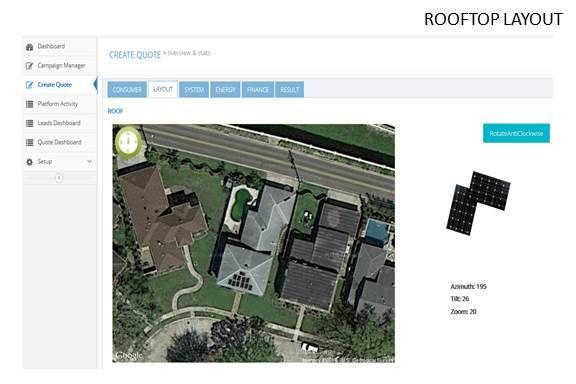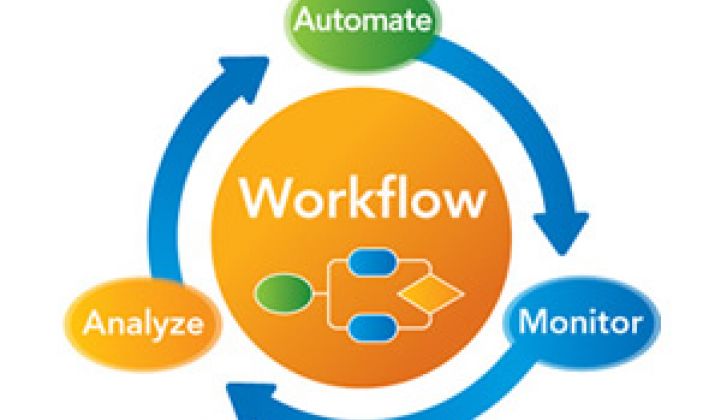The solar industry’s drive to reduce soft costs has produced a new variation on sales workflow automation.
EnACT, a just-launched software-as-a-service offering for solar, aims to streamline interactions between potential customers and providers of residential solar or energy efficiency.
The solar sales process has three steps, according to enACT CEO and founder Deep Chakraborty. First is origination, the pursuit of the customer; second is inside sales, which is about getting to an initial contract based on the estimated costs and benefits; and, finally, the on-site team does the roof assessment, design and installation.
EnACT can save “hours of time” in the first two steps and get to a “90 percent accurate estimate,” Chakraborty said. “To get to 100 percent accurate requires climbing the roof. No software tool can achieve that.”
By automating the sales process, the software eliminates inefficiencies in things like lead generation, proposal management, credit checks, and financial structuring. Addressing inefficiencies in customer relationship management with workflow automation lowers the transaction costs that are a big part of why solar can cost four times more in the U.S. than in other parts of the world, Chakraborty said.

An early step in every solar sales process is obtaining the customer’s energy bills for the most recent twelve-month period, Chakraborty explained. That can often take days or even weeks. “We solved that problem. We partnered with San Diego Gas and Electric to take advantage of the Department of Energy’s Green Button initiative. In San Diego, a one-click request and a one-click consent grants immediate access to twelve months of data on any customer’s energy usage. That’s an example of how every step in the process can be improved.”
EnACT intends to eventually provide the Green Button service to customers of the 3,500 utilities in its complete U.S. database. That database also includes every solar module manufacturer, every inverter manufacturer, and every bank and credit union that lends money for solar, Chakraborty said. “And we are adding PACE programs.”
Ambassador Energy was one of the twelve small- and medium-sized solar installers that took part in enACT’s beta test. Ambassador has used software-as-a-service tools ranging from its own in-house system to those supplied by SunPower and Sunnova, according to CEO Steve Fulgham. It is now using CPF Tools, but after using enACT “close to 50 times” during the beta test, Fulgham is switching.
“CPF runs $100 to $130 per seat,” he said. Chakraborty said enACT is $199 per month for ten or fewer users, and Fulgham confirmed that number. CPF did not reply to a request for a statement.
“CPF is the benchmark,” Fulgham said, “but it requires separate portals for different types of transactions, whereas enACT handles all transactions through the one portal.”
ModSolar and Genability are also competing in the online proposal/CRM space and seem to be out ahead of enACT and evolving their business models.
With enACT, companies that don’t have large sales forces “can focus on the customer and getting the transaction done,” Chakraborty said. It also is designed to manage the five sets of documents involved in most solar transactions and move companies from paper to online, Chakraborty said. “You can do a proposal in somewhere between five and ten minutes, even over the phone.”
EnACT will also be marketed as a service to financial institutions. K2 Clean Energy Capital, which is developing a new residential solar lease and loan program, was one of the beta test participants. “We were trying to make everything as automated and easy to use as possible,” explained K2 director and co-founder Jonathan Pickering. “We shopped around, and they were very price-competitive, they knew the sector, and they were fast and flexible, so they got the edge.”
EnACT’s designers solved the “mind-numbingly complicated” challenge of establishing a secure interface with K2’s finance company and built in features that included secure, sortable fields for each installer and solar product, Pickering added.
After using enACT for "hundreds of dummy transactions" over six months, "we know it works," Pickering said. “They are the real deal.”
During an online demonstration of the tool, Chakraborty said he expects to have 50 users and ample data documenting enACT’s cost-effectiveness within six months.
After an address was entered for the demonstration, the tool displayed a Google Earth image. Chakraborty chose module and inverter brands and used point-and-drag to create a hypothetical installation. He then used enACT databases to do energy output, cost, energy savings, and payback period calculations. The only misstep was when the database misidentified L.A. Department of Water and Power as the address’ utility instead of Southern California Edison.
EnACT’s databases and software also do cost-benefit calculations for combined solar-energy efficiency projects, Chakraborty said. “We see companies offering the full range of solutions including solar, lighting, HVAC, other efficiency upgrades, as a major trend. Our system can handle all of it.”



